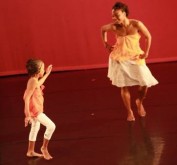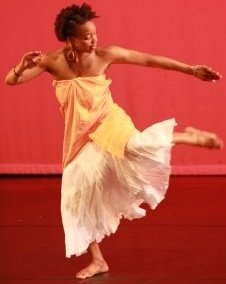Nichelle met Leila Anglin at the Dance/USA Conference last year in San Francisco. A bright, young dancer with much to say, Leila was invited to share her thoughts on graduating with a degree in dance and preparing for the career that follows.
After graduating from college with a BFA in dance,
I attended a cutting edge teacher education program and was determined to revolutionize education by teaching secondary social studies strictly through art.

Bill Herbert
In this program, we were learning how to facilitate fruitful learning experiences, where a classroom of diverse learners would have the space and freedom to critically and collectively construct knowledge for themselves.
Coming from a dance degree program, of course I understood a student’s “learning style” to be synonymous with an artist’s “creative process” which sparked a whole line of questioning for me.
Similar to the way that study skills and learning styles are not brought up with students until a life skills course during the last moments of high school, “creative process” did not make its way into my vocabulary until after my undergraduate years as a dance student.
Why is that?
Knowledge of self as a learner could go a long way for: the high school senior making the final decision on what to do after graduation, the first year college student considering both a part-time job and enrolling in on-line classes, or even the aspiring performing artist considering a full-time desk job.
Artists do not have the luxury of not being an expert on the process by which their work is conceived.
Without understanding how and why your art comes to be, how can you grow as an artist? How will you communicate your work to audiences, funders, or colleagues-let alone write about it?
I learned more about the nature of my creative process during my year learning to teach secondary social studies than in my four years as an undergraduate dance major. Without practice in discussing the origins of my artistic practice what kind of “artist” was I expected to be upon receiving my BFA?
I have spent a year in a teacher education program, three years working as an arts administrator and four years learning to navigate the San Francisco Bay Area dance community.
Along with invaluable lessons in life, love and art I have had to question whether my degree program really prepared me for the reality of living as an artist.
Did I miss class the day we covered the clear-cut instructions on how to use my dance degree?
My senior capstone course sought to teach practical skills, i.e. how to write an artist statement and map a personal web of connectivity. At the time, I saw value in learning how to prepare a project budget and was excited to do so.
But when you’re seriously debating whether to dip into October’s grocery money to pay for a dance class, it’s a bit more immediate that you know why you’re entertaining this “absurdity.”
I believe that we should all know why we make the decisions we make regardless of the absurdity. I have low iron and therefore crave/consume red meat often. I choose not to wear bras because they force me to choose between comfortably breathing and “support”. In the same way, I choose dance over an extra workday because, as part of my prayer life, it grounds my spirit in peace.
Being an experiential learner has me learning and continuously amending the lesson, that dance is a non-negotiable part of my life. Nine months of an uncompleted teacher education program, was just the beginning of this lesson three years ago.
I recognize no professor or course is going to read my heart back to me, but too many young dancers complete college feeling duped by undergraduate dance degree programs. Writing budgets aren’t worth the time and headache to a dancer too busy working to support their dancing, yet aren’t dancing enough to remember why they should care enough to be bothered with a budget.

Dr. Sally Sommer of Florida State University’s Department of Dance recognized that the environment of a university dance department provides “little chance to collide with different ideas about…what art is, and why they [students] are doing it.” She asserts, “These are core issues that must be confronted by any serious young artist.”
This led to Dr. Sommer and Tricia Young initiating the FSU in NYC, which challenges graduate students to explore, navigate and immerse themselves in the depths of NYC as a consumer and contributor with the belief that, “…students need to understand…feel…the difference between the accommodating womb of the university and the touch dynamic life-style of young NYC dancers.”
The National College Choreography Initiative published a resource guide titled Dance from the Campus to the Real World (And Back Again), with insightful essays from artists at various stages in their careers sharing and reflecting on their journeys through the ”real world.”
I am frustrated by this term in particular.
Dancers are one of the few populations in a university’s student body that has been studying their discipline for a hefty chunk of their conscious lives, in what would appear to me to be the “real world”. To talk about life after college as the “real world”, among other things, perpetuates the myth that there are clear benchmarks to measure whether or not a dancer has “made it” in the “real world.”
In the global economy of 2013 what does it mean to “make it”?
We live in a society using its struggling economy to justify not funding the arts, but instead applauding the seemingly innate ability of artists to spin straw into gold — that is create something from nothing.
Faced with this reality as an artist, it does a college student no good to luxuriate in the myth that the “real world” is this grand and raw experience they won’t have to deal with until after graduation.
The shows and performance opportunities of the “real world” frequently penetrated the awareness of students in my department, where a majority of the faculty were working dancers/choreographers. Unfortunately, the infiltration was rarely capitalized upon as “teaching moments” or even a space of dialogue on how or why we: do => study => live dance.
At the college level, dance students should be questioned and expected to investigate their role in art and the role art plays in their lives.
The first year of law school is said to be the hardest of the 3 years for law students. Why shouldn’t dance students be as strenuously wrung and forced to question if the art of dance is what they want their lives to reflect?
College is the time for discovery before young adults are rudely slapped into reality, which makes it the most ideal time to find out that dance is (not) something they’re willing to grapple with.
The time spent as a dance major is a series of critical moments in a young artists’ world and is wrought with possibility for growth and exploration in what it means to be a dancer => dance maker => artist.
I now understand that what was missing from my four years of undergraduate training was the space and time to engage in substantial reflection on my role as an artist in society.
I wish I had been compelled to critically engage with my art.
I wish I had had the nudge that required me to consider what I expected to do with my art in the “real world.” And then a little push to experiment with those possibilities before the safety net-included in my tuition-dissolved on graduation day.
What would dance be 10 years from now, if curriculum in undergraduate dance programs focused on inciting the artist in young dancers?
Leila Anglin is thankful for the four years of education the San Francisco Bay Area afforded her following the receipt of her BFA in dance, from an overall awesome university in her hometown of Philadelphia, PA. While dance is the longest relationship Leila has ever been in (after her mother), she still considers herself a novice learning her ever-changing body and it’s responses to rhythm and movement. Leila’s passions for: the quality presentation and preservation of art in the African Diaspora, quality equitable care for women throughout their reproductive cycle, and living God’s will for her life are all coming together this summer as she excitedly begins the journey towards her MFA.

Dance Advantage welcomes guest posts from other dance teachers, students, parents, professionals, or those knowledgeable in related fields. If you are interested in having your article published at Dance Advantage, please see the following info on submitting a guest post. Read posts from guest contributors.

